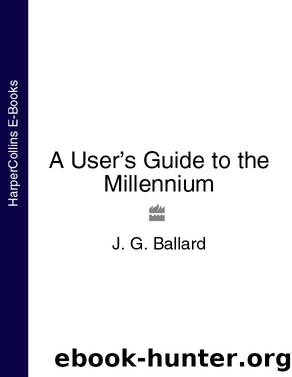A User's Guide to the Millennium by J. G. Ballard

Author:J. G. Ballard
Language: eng
Format: epub
Publisher: HarperCollins Publishers
Published: 2013-11-18T00:00:00+00:00
Magnetic Sleep
From Mesmer to Freud
Adam Crabtree
The history of psychiatry rewrites itself so often that it almost resembles the self-serving chronicles of a totalitarian and slightly paranoid regime. One-time pioneers are suddenly demoted and deemed to be little more than package tourists. Sigmund Freud, far from being the heroic first explorer of the unconscious mind, now seems to be one of the last to step off the gangway, as Adam Crabtree makes clear in this account of the precursors of psychoanalysis.
The unlikely figure who first raised the curtain on the era of modern psychology was Franz Anton Mesmer, a Viennese physician born in 1734, whom I have always associated with ouija boards, stage hypnotists and other assorted quackeries. In fact, he was a sceptical physical scientist deeply opposed to all paranormal phenomena. While practising as a doctor he became interested in the power that magnets seemed to exert over the workings of the human body. A Jesuit priest, with the daunting name of Father Hell, had developed a cure for stomach cramps involving the use of iron magnets. Mesmerâs careful experiments convinced him that currents of force, which he dubbed âanimal gravityâ, moved beneficially between doctor and patient. The most important magnet, he believed, was the human body, and he enjoyed a remarkable run of success, treating everything from haemorrhoids and paralysis to epilepsy and melancholia.
Despite his immense fame, Mesmer was distrusted by the orthodox medicine of his day, but he was able to pass on his torch to the most remarkable of his French pupils, the Marquis de Puységur, a former artillery officer intrigued by the phenomenon of electricity. After being trained by Mesmer at his Society of Harmony in Paris, Puységur turned his skills upon the daughter of his estate manager, who was suffering from toothache, and began a series of experiments that Adam Crabtree claims were to alter the course of psychiatry for ever. While laying on his hands, Puységur discovered that his patients sank into what he termed âmagnetic sleepâ. This was a state of sleep-walking consciousness during which the patients became extremely suggestible, developed an intense rapport with the therapist, but on awakening remembered nothing. It clearly foreshadowed both Freudâs therapeutic couch and the spotlit stage of the music-hall hypnotist.
Mesmer always believed his powers of healing were physically based, but Puységur was confident that the therapeutic benefits of the magnetic trance were wholly psychological. Indeed, many physicians were already worried about the painful secrets revealed by the entranced patients and the dangers of âunhealthyâ sexual attachment. Puységur, one observer noted, placed his hands on the head of a woman patient, gently tickled her nostrils and âpressed on her breasts in a manner that her nipples would have felt a slight rubbingâ. In âlively and sensitive womenâ convulsions occurred, with sudden movements of the arms and legs, the discharge of âthe sweetest emotionsâ, followed by a state of languor and weakness. Surprisingly, the observer noted, the women felt no guilt and were ready to repeat the experience.
Well,
Download
This site does not store any files on its server. We only index and link to content provided by other sites. Please contact the content providers to delete copyright contents if any and email us, we'll remove relevant links or contents immediately.
| Diaries & Journals | Essays |
| Letters | Speeches |
The Rules Do Not Apply by Ariel Levy(4842)
Bluets by Maggie Nelson(4472)
Too Much and Not the Mood by Durga Chew-Bose(4270)
Pre-Suasion: A Revolutionary Way to Influence and Persuade by Robert Cialdini(4144)
The Motorcycle Diaries by Ernesto Che Guevara(4009)
Walking by Henry David Thoreau(3892)
Schaum's Quick Guide to Writing Great Short Stories by Margaret Lucke(3317)
What If This Were Enough? by Heather Havrilesky(3270)
The Daily Stoic by Holiday Ryan & Hanselman Stephen(3228)
The Day I Stopped Drinking Milk by Sudha Murty(3159)
The Social Psychology of Inequality by Unknown(2936)
Why I Write by George Orwell(2874)
Letters From a Stoic by Seneca(2733)
A Short History of Nearly Everything by Bryson Bill(2627)
A Burst of Light by Audre Lorde(2545)
Insomniac City by Bill Hayes(2494)
Feel Free by Zadie Smith(2433)
Upstream by Mary Oliver(2339)
Miami by Joan Didion(2322)
